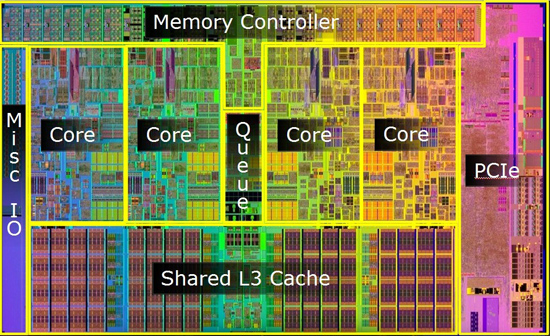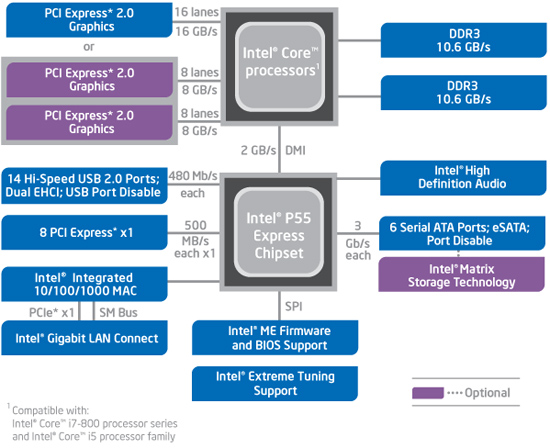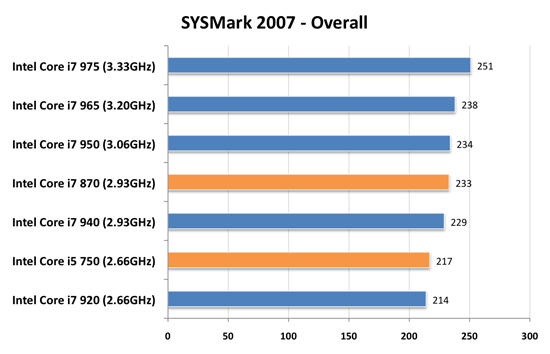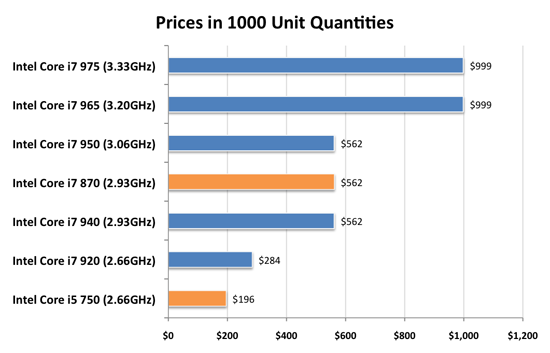Intel's Core i7 870 & i5 750, Lynnfield: Harder, Better, Faster Stronger
by Anand Lal Shimpi on September 8, 2009 12:00 AM EST- Posted in
- CPUs
Intel is on the verge of transitioning to 32nm. We'll see the first parts this year. What do you do with your 45nm fabs when you start moving volume away from them? Make really cheap quad-core Nehalems of course:

I'm talking $196. I'm talking faster than AMD's entire lineup. I'm talking about arguably the best processor of 2009. I'm talking about Lynnfield, and here's its backside:

Mmm
I spent much of the past year harping on AMD selling Nehalem-sized Phenom IIs for less than Intel sold Nehalems. With Lynnfield, Intel actually made Nehalem even bigger all while driving prices down. Like I said, what do you do when you're still making boatloads of money in a recession and are about to start emptying your 45nm fabs?
I should clear things up before we progress much further. Lynnfield is the codename for mainstream 45nm quad-core Nehalem, while Bloomfield refers to the first Nehalem launched at the end of 2008:
| Processor | Manufacturing Process | Die Size | Transistor Count | Socket |
| Bloomfield | 45nm | 263 mm2 | 731M | LGA-1366 |
| Lynnfield | 45nm | 296 mm2 | 774M | LGA-1156 |
Despite being cheaper, Lynnfield is larger than Bloomfield. The larger die is due to one major addition: an on-die PCIe controller.

Bloomfield, The First Nehalem, circa 2008

Lynnfield, Nehalem for All, circa 2009
The pink block to the right of the die is the PCIe controller, that's 16 PCIe 2.0 lanes coming right off the chip. Say hello to ultra low latency GPU communication. You'd think that Intel was about to enter the graphics market or something with a design like this.
Sacrifices were made to reduce CPU, socket and board complexity. Gone are the two QPI links that each provided 25.6GB/s of bandwidth to other CPUs or chips on the motherboard. We also lose one of the three 64-bit DDR3 memory channels, Lynnfield only has two like a normal processor (silly overachieving Bloomfield).

Intel's Bloomfield Platform (X58 + LGA-1366)
The sum is that Lynnfield is exclusively single-socket; there will be no LGA-1156 Skulltrail. While the dual-channel memory controller isn't really a limitation for quad-core parts, six and eight core designs may be better suited for LGA-1366.

Intel's Lynnfield Platform (P55 + LGA-1156)
The loss of QPI means that Lynnfield doesn't have a super fast connection to the rest of the system, but with an on-die PCIe controller it doesn't matter: the GPU is fed right off the CPU.
The Lineup
We get three Lynnfield CPUs today: the Core i7 870, Core i7 860 and the Core i5 750. Intel's branding folks told us that the naming would make sense one we saw the rest of the "Core" parts introduced; yeah that was pretty much a lie. At least there aren't any overlapping part numbers (e.g. Core i5 860 and Core i7 860).
The i7 in this case denotes four cores + Hyper Threading, the i5 means four cores but no Hyper Threading. The rules get more complicated as you bring notebooks into the fray but let's momentarily bask in marginal simplicity.
| Processor | Clock Speed | Cores / Threads | Maximum Single Core Turbo Frequency | TDP | Price |
| Intel Core i7-975 Extreme | 3.33GHz | 4 / 8 | 3.60GHz | 130W | $999 |
| Intel Core i7 965 Extreme | 3.20GHz | 4 / 8 | 3.46GHz | 130W | $999 |
| Intel Core i7 940 | 2.93GHz | 4 / 8 | 3.20GHz | 130W | $562 |
| Intel Core i7 920 | 2.66GHz | 4 / 8 | 2.93GHz | 130W | $284 |
| Intel Core i7 870 | 2.93GHz | 4 / 8 | 3.60GHz | 95W | $562 |
| Intel Core i7 860 | 2.80GHz | 4 / 8 | 3.46GHz | 95W | $284 |
| Intel Core i5 750 | 2.66GHz | 4 / 4 | 3.20GHz | 95W | $196 |
Keeping Hyper Threading off of the Core i5 is purely done to limit performance. There aren't any yield reasons why HT couldn't be enabled.
Intel was very careful with both pricing and performance of its Lynnfield processors. I'm going to go ahead and say it right now, there's no need for any LGA-1366 processors slower than a Core i7 965:

This is only one benchmark, but it's representative of what you're about to see. The Core i7 870 (LGA-1156) is as fast, if not faster, than every single LGA-1366 processor except for the ones that cost $999. Its pricing is competitive as well:

For $196 you're getting a processor that's faster than the Core i7 920. I'm not taking into account motherboard prices either, which are anywhere from $50 - $100 cheaper for LGA-1156 boards. I don't believe LGA-1366 is dead, but there's absolutely no reason to buy anything slower than a 965 if you're going that route.










343 Comments
View All Comments
TA152H - Wednesday, September 9, 2009 - link
Your assumption would be wrong, I use computers for the normal stuff people do, and compiling.Go back to picking your nose, lowlife.
Skiprudder - Tuesday, September 8, 2009 - link
I'm starting to feel like some folks have Bloomfields and now they're trying to justify spending the money they did. At no point did Anand say Bloomfields were 'bad', he's just pointing out that due to current price/performance ratios the new chips are fantastic for the vast amount of folks here. They really area big step up for a lot of people, and frankly a lot of us feel we have better things to spend out money on than $300 X58 mobos. We can now get in on that sort of performance (or better) for a reasonable price, and how isn't this great?TA152H - Tuesday, September 8, 2009 - link
Well, you might be right, but within this context I'm going to assume you are talking about me, in which case you would be wrong.I don't have anything new, and I'm actually not going to get anything for a few months. Even if I did, I wouldn't let it cloud my perspective. Normally people who make these judgments are looking through their own personality flaws. I have many, but this is one area I do not.
Maybe I am annoyed at the processor because I was expecting more. I was expecting it to be a really nice processor, and it turned out disappointing. I get annoyed with stupid things sometimes, like the 4 clock cycle L1 cache irks me big time with the Nehalem. With the P55, the platform is just weak and I don't really like it when sites do everything they can to obfuscate the compromises in it.
I'll say this, though, about it, the power use is REALLY nice. I'm really impressed with that. Everything else though, just leaves me cold.
There are some questions that need to be asked, as well. Why is the P55 so damn expensive? It's the same cost as the P45, but without most of the logic.
Why is the 870 so expensive? Is there really any point to this processor at this cost? Maybe some, but not really for a broad segment of the buying population. I'd much rather have an LGA1366 if I were going into that type of expense, instead of the brain-damaged derivative.
LGA1366 motherboards are around $200 now, at least many are, so $300 is kind of an outdated number. For this, you get better i/o, better memory flexibility (you can use two or three dimms; you can't use three with a P55), better performance, etc...
Now, one thing Anand brought up, and I didn't respond to, was something about not needing more bandwidth unless you were tapping out all four processors. Needless to say, this is obviously false, and I wonder why he'd repeat it. A little thought would tell us that even with two cores running, you could gain advantages by having better bandwidth. The reason is simple. Let's say Core A and Core B are both plugging away, and Core A needs a memory read. OK, so it takes the bus, and starts the long process of getting a cache line read. Now, let's say a clock cycle, or two, or twenty, later, Core B needs memory outside of cache. So now it needs the memory bus. Hmmmm, but Core A has the bus. So, Core B has to wait. If you have three memory channels, you transfer data faster, satisfying the cache line faster, and freeing the bus sooner. So, now Core B can get it, and start working sooner. So, you could see better performance with lower processor use requirements than they indicate.
Now, the only possibility this premise is wrong is if the core only grabs 64-bit memory bank at a time, which seems very unlikely to me. In this event, there would still be one memory channel open to the second processor, thus no penalty would occur until three processors needed memory. I don't think this is what they did, as it would lower memory performance on the Bloomfield unless three processors were being used, and also, based on the shared L3 cache, it seems the entire memory bus is always used. Still, it is possible. Maybe Anand can answer this.
mesiah - Wednesday, September 9, 2009 - link
Dude, you are so full of shit they can smell it 3 states away. Don't you dare try to rationalize by saying "I was expecting more." Since lynnfield news first broke you have done nothing but trash the part, Call it brain damaged, and skew posted facts to fit your warped agenda. Then, when the retail part is finally unveiled, instead of eating crow (something you suggest Anand do) you act like every crazy half baked conspiracy theorist that ever existed and start ranting about biased reporting, facts being intentionally hidden, and flawed logic.While I will admit that this isn't the be all end all lynnfield review, this is day one of the launch. I believe more information was displayed in this review than can be reasonably expected for the initial review. In depth overclocking comparisons and the like will certainly come later, but that isn't to say overclocking was ignored.
You read the article and then go off on a tirade about biased reporting and the skewing of facts to meet an agenda when it is you that have been skewing facts all along, and you continue to do so. You make overclocking comparisons between lynnfield and bloomfield calling them similar, then ask why anyone would give up "all the other advantages" of the bloomfield if you are overclocking, but you fail to mention the big advantage for most, which is price comparison. Then later you try to rationalize price by quoting the lowest posted 920 sale price next to the 870 msrp. The parts hit the shelves today, give them a month for prices to normalize. You aren't going to get a smokin deal on the first one to roll off the production line.
Now, go ahead and call me a fool like you do everyone else that is smart enough to see you for what you are. Attempting to verbally abuse another person in order to make yourself feel smarter is a pretty common tactic for feeble minded people who are themselves afraid of looking stupid. Its the equivalent to bringing a gun to a fist fight just in case you start to get your ass beat. So, how about you stop being a pussy, eat a little crow, and admit that all of your talk about how terrible this part was going to be was wrong. Or better yet, just stop posting here because your pissy "I'm better than you" attitude does nothing but bring the site down.
You can reply and call me all the dirty names you want, you wont get a response. I only feed the trolls once a week.
TA152H - Wednesday, September 9, 2009 - link
Actually, you're an idiot, and you're changing my words to create an argument.I never said it was terrible, I said the pre-release performance was terrible, and I expected it to be better for the released version. It was, but I still don't think so highly of the processor, and I wouldn't consider it. I'd rather get the i7 920.
If you're going to argue, at least have the decency/intelligence to not misrepresent someone's position.
I didn't really read the rest of your crap. I could only skim through your sub-literate drivel. I doubt you would have said anything useful in it.
Skiprudder - Thursday, September 10, 2009 - link
Can you please stop referring to people as idiots and morons? I'm not sure where you acquired your rhetorical skills, but calling folks names is the last thing one should do if you're actually trying to convince people of your viewpoint. Call someone here a moron, and it makes you look like just a troll. Calm down, stay rational, and people will be much more likely to hear what you have to say (and if they aren't, why should you care anyway?) There's no excuse for rudeness.Skiprudder - Tuesday, September 8, 2009 - link
I agree, the 870 isn't priced at all sensibly (but I would argue the top Bloomfields are pretty darn unreasonable too). Prices are rather high right now, and it will be interesting to see what they do over the next few weeks as supplies and demands start to balance out.chrnochime - Tuesday, September 8, 2009 - link
The sad thing is, right now(at least), in order to get i7 CPU and decent MB to OC with, a P55 set up would run:~300 for the i7 860
plus
~200 for an UD4P or an Asus P55 Pro.
Whereas for a x58 setup,
I can get an i 7 920 for 200 pre-tax, and should spend about 230-250 for a decent motherboard.
So for me, it's actually cheaper to go with the x58 setup, even though P55 MB are supposed to be cheaper...
TA152H - Tuesday, September 8, 2009 - link
Yes, and you'd end up with better performance too. And better i/o, and better flexibility.Once you factor in overclocking, the P55 isn't really much of an option unless you go to it's really low end, where you simply can't build an x58. Then it's competing with the Core 2, and has a chance.
ClownPuncher - Tuesday, September 8, 2009 - link
Good article, thanks for the clarifications too.